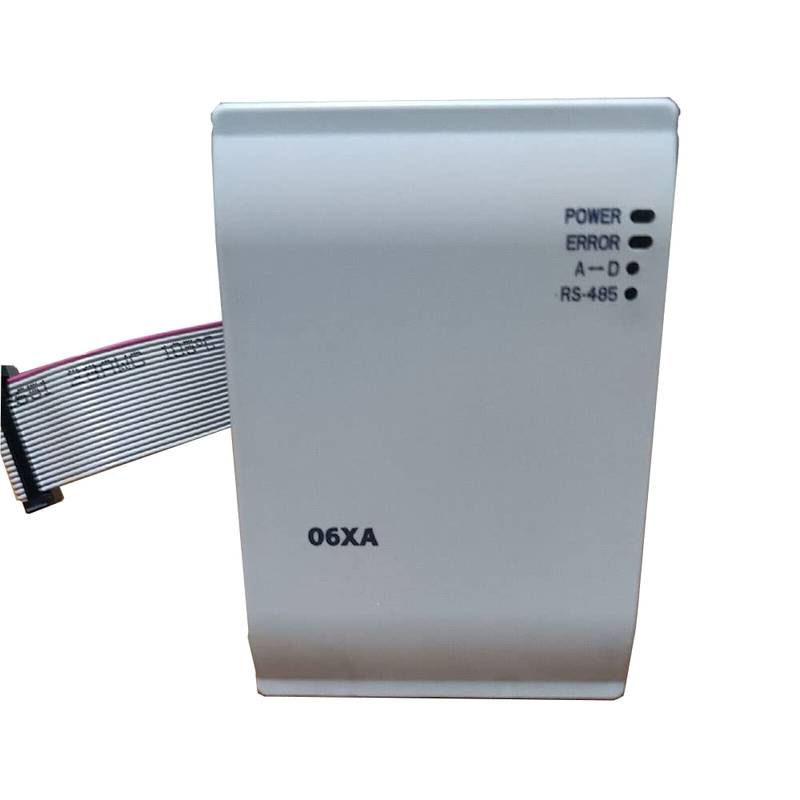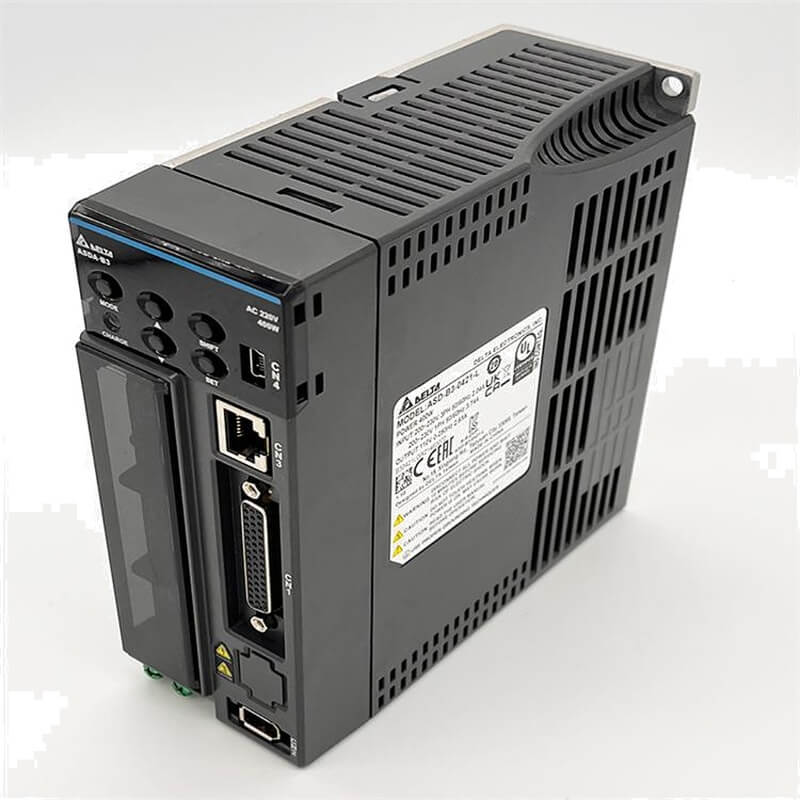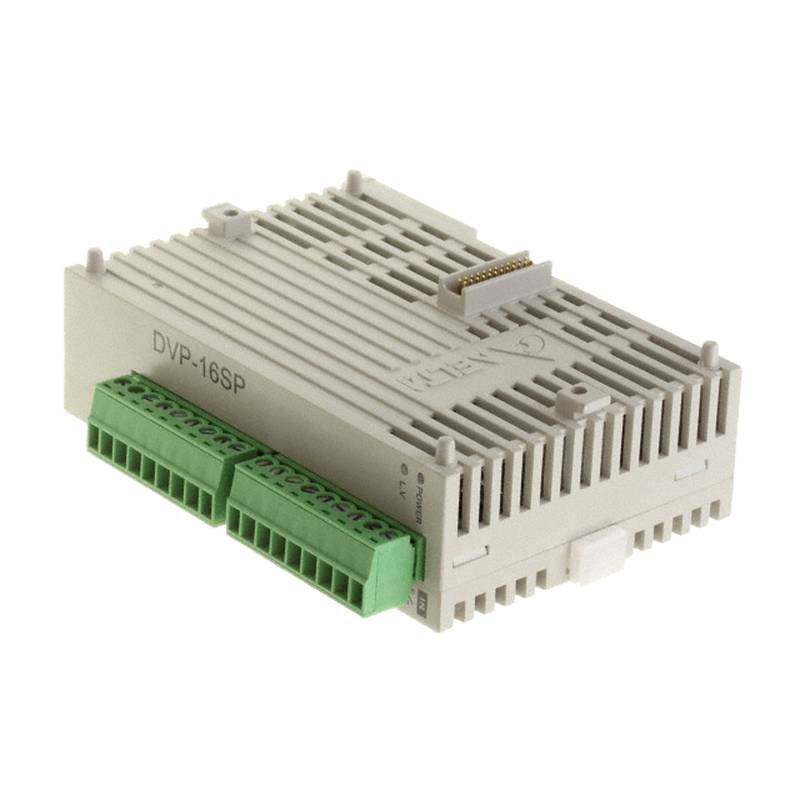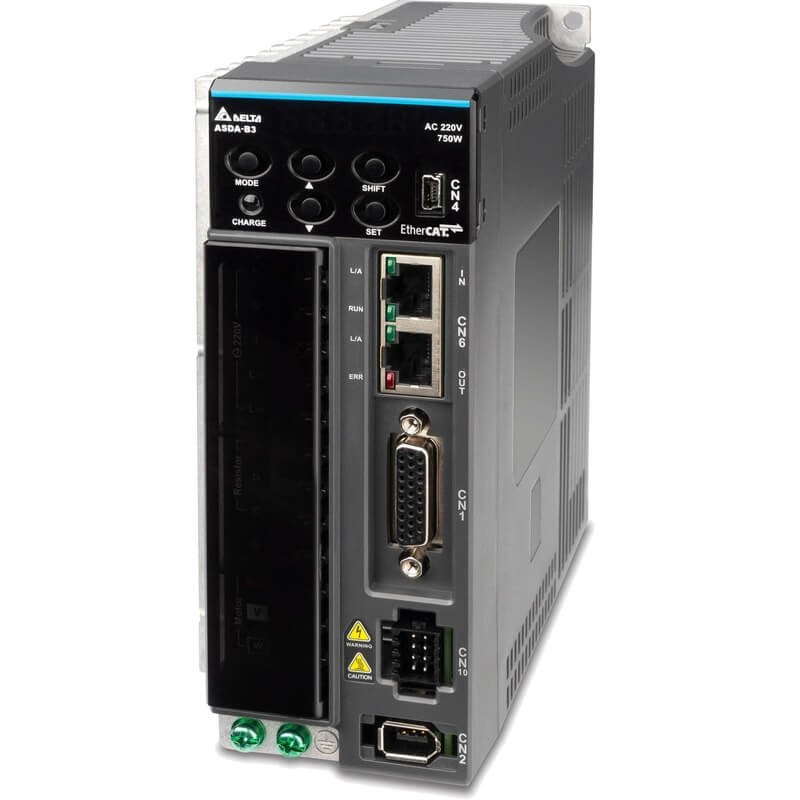
The Delta DVP06XA-H3 is a versatile 6-channel analog input/output mixed module designed to enhance the control capabilities of Delta's DVP series Programmable Logic Controllers (PLCs). This module offers significant advantages in industrial automation by providing flexible signal conversion and expansion, allowing for precise measurement and control of analog processes. Its core features include a high-speed processing capability, robust signal isolation, and user-friendly configuration, making it a compelling choice for complex automation tasks. Key technical parameters highlight its adaptability: it supports multiple input types such as voltage and current, and offers configurable output ranges for seamless integration into diverse system architectures.
Product Specifications
| Feature | Specification |
| :---------------------- | :------------------------------------------------ |
| Channels | 6 (3 Analog Inputs, 3 Analog Outputs) |
| Analog Input Types | Voltage (±10V, 0-10V, 0-5V), Current (0-20mA, 4-20mA) |
| Analog Output Types | Voltage (±10V, 0-10V), Current (0-20mA, 4-20mA) |
| Resolution | 16-bit |
| Sampling Rate | Up to 50kS/s per channel |
| Isolation | Channel-to-channel, Channel-to-ground |
| Power Consumption | 5V DC, 130mA; 24V DC, 50mA |
| Operating Temperature | 0°C to 55°C |
| Dimensions | 86mm x 90mm x 33mm |
Core Features & Market Positioning
The Delta DVP06XA-H3 distinguishes itself through its high-resolution 16-bit conversion, ensuring exceptional accuracy in analog signal processing, a critical factor in precision-driven industrial applications. This module's flexibility in supporting a wide array of input and output signal types (voltage and current) without requiring external converters simplifies system design and reduces component count, offering a distinct cost and space advantage. Its robust isolation between channels and from ground significantly enhances system reliability by protecting against electrical noise and ground loops, a common challenge in harsh industrial environments. Positioned as a cost-effective yet high-performance expansion module, the DVP06XA-H3 empowers users to precisely monitor and control a greater number of analog variables, making it an attractive option for SMEs and larger enterprises seeking to optimize their automation strategies.
Key Application Scenarios
The Delta DVP06XA-H3 is ideally suited for a broad spectrum of industrial applications demanding precise analog signal handling. In temperature control systems, its multiple input channels can monitor diverse temperature sensors (e.g., thermocouples, RTDs via transmitters) simultaneously, while its output channels can precisely regulate heating elements or cooling systems, ensuring optimal process conditions. For liquid level and flow control, the module effectively processes signals from level transmitters and flow meters, enabling sophisticated feedback loops to maintain precise fluid management in chemical processing, water treatment, and food and beverage production. Furthermore, in motor speed and position control within manufacturing lines, the DVP06XA-H3 can receive feedback from variable speed drives and control analog output signals for precise torque or speed adjustments, contributing to enhanced product quality and throughput.
Practical System Integration Guidance
Integrating the Delta DVP06XA-H3 into an existing Delta DVP PLC system is streamlined through direct module slot insertion and straightforward wiring. For analog inputs, connect the sensor's output signal wires to the designated IN+ and IN- terminals, ensuring correct polarity for current or voltage signals as per the module's configuration. Analog outputs require connecting the load (e.g., VFD speed control input, indicator) to OUT+ and OUT- terminals, again respecting polarity and signal type (voltage or current). Configuration within the Delta ISPSoft programming software is intuitive; users select the DVP06XA-H3 module in the hardware configuration, then map the input and output channels to specific PLC memory addresses. The software allows for the selection of input/output ranges and signal types (voltage/current) for each channel through simple dropdown menus, eliminating the need for complex hardware jumpers or recalibration.
Operation and Risk Mitigation
Operating the Delta DVP06XA-H3 requires adherence to specified environmental conditions and proper wiring to prevent damage and ensure accurate readings. Users must ensure the module operates within its specified temperature range (0°C to 55°C) and is protected from excessive dust, moisture, or corrosive atmospheres. Electrical risks are mitigated by confirming that input and output signal voltages and currents do not exceed the module's specifications, and by ensuring proper grounding of the PLC system and connected devices. A common troubleshooting scenario involves incorrect signal type configuration (e.g., configuring for voltage when a current signal is present), which leads to erroneous readings; this is resolved by verifying the jumper settings (if applicable) and the software configuration within ISPSoft. Another potential issue is signal noise; robust shielding of analog signal cables and proper installation of the module away from high-power electrical equipment can significantly reduce this risk.
Scalability & Long-Term Value
The Delta DVP06XA-H3 offers excellent scalability, allowing users to expand analog I/O capabilities by adding multiple modules to compatible DVP series PLCs, accommodating growing automation requirements without a complete system overhaul. Its compatibility with the established Delta DVP platform ensures seamless integration with a wide range of existing Delta PLCs, HMIs, and servo drives, preserving investments in current automation infrastructure. The module's adherence to standard industrial analog signal protocols (0-10V, 4-20mA) also facilitates integration with third-party equipment, enhancing interoperability. As industries move towards Industry 4.0 and IIoT, the data acquired through the DVP06XA-H3 can be easily integrated into SCADA systems or cloud-based platforms via the PLC, providing valuable insights for predictive maintenance, process optimization, and advanced analytics, thereby ensuring long-term value and future-proofing automation investments.
Frequently Asked Questions (FAQs)
Q1: What is the maximum voltage input for the Delta DVP06XA-H3?
The Delta DVP06XA-H3 module supports a maximum analog input voltage range of ±10V. This allows for the measurement of signals that can swing both positive and negative relative to a common reference point, offering greater flexibility in certain applications.
When configuring the module, users can select specific voltage ranges such as 0-10V or 0-5V, in addition to ±10V, tailoring the input to the specific sensor requirements. This selection is typically made within the Delta ISPSoft programming software.
Proper wiring and avoiding signal excursions beyond the specified ±10V limit are crucial to prevent module damage and ensure accurate data acquisition. Always consult the module's manual for detailed wiring diagrams and specifications.
Q2: Can the Delta DVP06XA-H3 be used for both 0-20mA and 4-20mA current outputs?
Yes, the Delta DVP06XA-H3 module is designed to handle both 0-20mA and 4-20mA current output signals. This flexibility is critical for interfacing with various actuators, drives, and instrumentation that may use different standard current loop configurations.
The specific current output range (0-20mA or 4-20mA) is configurable through software settings in the Delta ISPSoft programming environment. This allows users to adapt the module's output to the requirements of the connected device without physical modifications.
It is important to ensure that the external device connected to the analog output can accept the configured current range and that the total loop resistance does not exceed the module's specified limits to maintain signal integrity and performance.
Q3: How many analog input and output channels does the Delta DVP06XA-H3 module have?
The Delta DVP06XA-H3 module is specifically designed as a mixed analog module, providing a total of six channels. These six channels are divided into three dedicated analog input channels and three dedicated analog output channels.
This configuration allows users to simultaneously monitor three different analog signals from sensors or transmitters and control three different analog devices or processes. The mixed nature streamlines I/O expansion for PLCs that require a balanced mix of input and output capabilities.
The specific designation of each channel as input or output is fixed by the module's hardware design and is clearly labeled, ensuring straightforward wiring and programming for each distinct function.
Q4: What is the resolution of the analog-to-digital (A/D) and digital-to-analog (D/A) conversion for this module?
The Delta DVP06XA-H3 module boasts a high resolution of 16-bit for both its analog input and analog output channels. A 16-bit resolution means that the analog signal is digitized into 2^16 (65,536) discrete levels.
This high resolution translates to very fine granularity in signal measurement and control. For example, with a 10V input range, the smallest voltage change detectable or controllable could be as low as approximately 0.15mV, ensuring high precision in demanding applications.
The 16-bit conversion capability is a key feature that sets this module apart, enabling accurate monitoring of subtle process variations and precise actuation of control elements, which is crucial in industries like pharmaceuticals or fine chemicals.
Q5: Can the Delta DVP06XA-H3 module be used with non-Delta PLC systems?
While the Delta DVP06XA-H3 is specifically designed as an expansion module for Delta's DVP series PLCs, its adherence to standard industrial analog signal protocols (voltage and current) allows for indirect integration with non-Delta systems.
Direct integration into a non-Delta PLC's backplane is not supported due to proprietary communication protocols. However, it can be interfaced with other systems through a Delta PLC acting as a gateway. The Delta PLC reads the analog values and communicates them to the other system via industrial Ethernet, Modbus, or other supported communication protocols.
Therefore, while not a plug-and-play solution for other PLC brands, its standard signal I/O makes it a viable component within a larger, multi-vendor automation architecture when implemented through a compatible Delta PLC.
Q6: What are the power requirements for the Delta DVP06XA-H3?
The Delta DVP06XA-H3 module requires two distinct DC power supplies for its operation. It draws 5V DC, with a consumption of approximately 130mA, typically supplied from the PLC's internal power bus.
In addition to the 5V DC, it also requires an external 24V DC supply, consuming around 50mA. This 24V DC supply is commonly used for powering the analog output circuits and often for powering the connected sensors or field devices, depending on the system design.
Ensuring both the 5V DC from the PLC and the external 24V DC are correctly connected and within specified voltage tolerances is essential for the module's proper functioning and to prevent potential damage.
Q7: How is the Delta DVP06XA-H3 module installed into a Delta DVP PLC?
Installation of the Delta DVP06XA-H3 module is a straightforward process involving physical insertion into an available expansion slot on a compatible Delta DVP PLC main unit or an expansion chassis. The module is designed with a specific connector that mates with the PLC's backplane.
Once physically seated, the module is typically secured with screws to ensure a stable connection and to meet vibration resistance standards common in industrial settings. Proper seating is crucial for reliable communication between the module and the PLC processor.
After physical installation, the module must be recognized and configured within the PLC programming software (e.g., Delta ISPSoft) to allocate its I/O points and set operational parameters, effectively bringing it online for use in the automation logic.
Q8: What are the typical error codes or fault indications for the Delta DVP06XA-H3?
While specific numerical error codes can vary and are detailed in the comprehensive Delta PLC manuals, common fault indications for analog modules like the DVP06XA-H3 often relate to input signal over-range, under-range, or open-loop conditions. Software diagnostics within ISPSoft will usually flag these issues.
For instance, if an analog input signal exceeds the configured maximum range (e.g., >10V or >20mA), the PLC program might trigger a fault. Similarly, an open circuit on an input or output can be detected and reported as an error state.
Users should regularly monitor the PLC's diagnostic status and the module's status indicators (if present) and refer to the specific model's technical documentation for a precise interpretation of fault codes and recommended troubleshooting steps.
Q9: Does the Delta DVP06XA-H3 offer channel-to-channel isolation?
Yes, the Delta DVP06XA-H3 module provides robust channel-to-channel isolation. This means that the electrical path for each analog input and output channel is independent of the others, preventing interference or signal coupling between them.
Additionally, the module typically offers channel-to-ground isolation, which further enhances system reliability by preventing ground loops and protecting against transient voltage differences between different grounding points in the installation.
This comprehensive isolation is a critical feature for industrial environments where electrical noise is prevalent, ensuring data integrity and protecting the PLC and other connected equipment from potential damage due to electrical disturbances.
Q10: How can I configure the input type (voltage or current) for the Delta DVP06XA-H3?
The input type (voltage or current) for each analog input channel on the Delta DVP06XA-H3 is configured software-wise using Delta's ISPSoft programming tool. Within the hardware configuration section of the PLC project, you select the DVP06XA-H3 module.
For each of the three analog input channels, there will be options to select the desired input range and signal type, such as 0-10V, ±10V, 0-5V for voltage inputs, or 0-20mA, 4-20mA for current inputs. The module internally adjusts its circuitry based on this software setting.
After setting the input type in ISPSoft, download the configuration to the PLC. It is also good practice to double-check the wiring to ensure it matches the selected input type (e.g., connecting a 4-20mA sensor to a current input terminal).
























